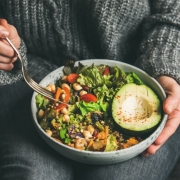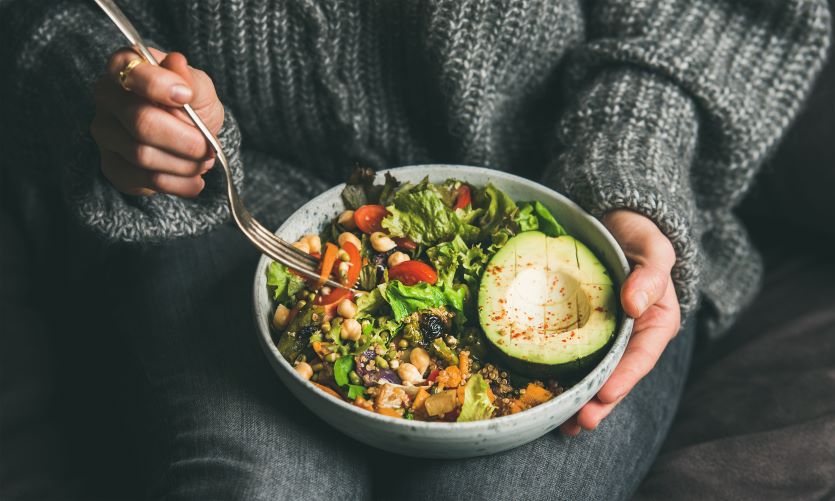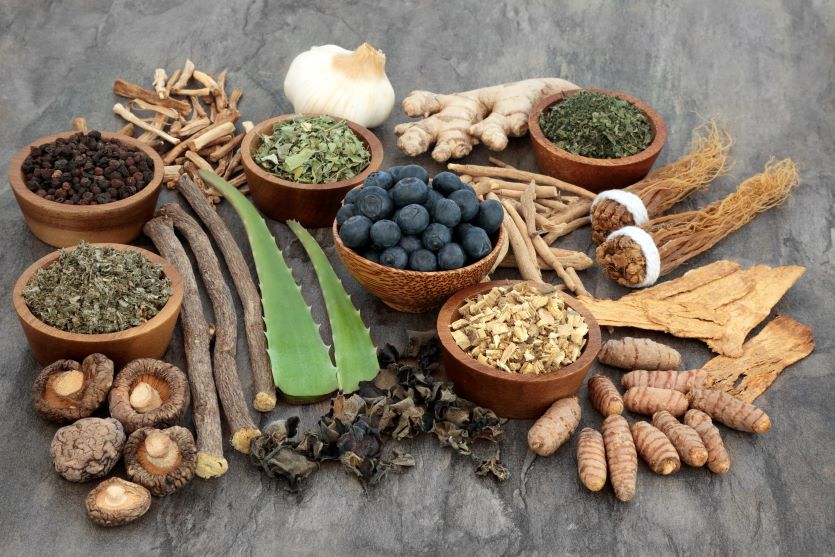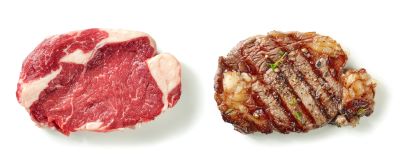If asked, most people will say they’d like to live a healthier lifestyle. But when it comes to actually changing—well, that’s another story. So why do so many of people’s health goals go unrealized? One of the most common answers: “I want to be healthier, but I just don’t have time.”
If you’ve ever had a similar thought, you may need to reframe the way you think about healthy living. Being “healthier” doesn’t necessarily mean adding more to your already crammed calendar. Instead of further bloating your busy schedule, try integrating healthier habits into your established routines. It’s all about adjusting and substituting (more on that later).
So what exactly does this look like? As with many lifestyle questions, there’s no single, right answer—it all depends on you, your existing habits, and the changes you’d like to make. Fortunately, you don’t have to dive in without guidance. Whether you’re looking for ways to incorporate exercise into your workday, eat more nutritious meals, or simple health and wellness tips, you’ve come to the right place.
Since healthy living is highly personal, remember that what follows isn’t an exhaustive list, nor a set of steps to follow exactly. Think of it as a tasting menu—you can try different approaches out to see what fits with your schedule and helps you feel your best.
What is Healthy Living?
Most people are familiar with the basics of health and wellness: eat nutritious foods, exercise regularly, and get enough sleep. These are great starting points, but there’s just one problem—these practices are all rather vague. How much should you exercise? What foods should you eat? And how much sleep is “enough”? There’s a good chance you’ve asked yourself (and the internet) similar questions.
Internet searches have probably returned some general guidelines. The CDC (Center for Disease Control and Prevention in the United States), for instance, recommends adults get at least an hour and a half of exercise each week. And there are plenty of articles on nutritious eating that can help you out.
There’s so much available information that it can be intimidating. It can also prove difficult to distill these general guidelines and suggestions into specific, actionable steps for your life. If you’ve ever felt overwhelmed as you navigate your health and wellness journey, refocus on the most important factor: you.
Health and Wellness Tips for the Workplace
The main culprit responsible for people’s busy schedules is work. Most can agree on one thing: too much time is spent working. This can make it difficult to incorporate wellness practices—especially exercise—into daily life. People typically try to exercise in one of two blocks of time: before or after work.
A pre-work exercise routine is a great way to start the day, but it’s not for everyone. And the same can be said for evening workouts. Fortunately, there are other options—you’ve just got to be a little creative. Here are a few ways you can sneak some exercise at work.
- Try a treadmill desk: You’ve probably seen, or at least heard about, standing desks. If not, the concept is simple: it’s a desk you stand at rather than sit behind. Standing desks have been all the rage in recent years, in part because of their perceived health benefits. And while there may be slight benefits to sitting less and standing more, recent studies suggest the difference in calories burned is minimal.
Enter the treadmill desk. Rather than simply standing at your desk, you have the option to walk in place. This simple change can drastically increase the number of calories you burn each day, and, if you walk at a brisk pace, help amp up your heartrate during the workday. - Cycle during meetings: Treadmill desks are expensive, but workplace exercise doesn’t have to break the bank. For a cheaper—and often more discrete—exercise option, try cycling at your desk. Obviously, you’re not going to actually ride a bicycle in the office, but there are under-desk cycles that have become increasingly popular.
Basically, these cycles are a set of bicycle pedals on a small stand that can sit under your desk. As you sit in your office chair, you can pedal away to get the blood flowing. Most machines have variable intensities, allowing you to customize your workout each day. And the best part? You can still sit at your desk for virtual meetings. - Change up your commute: Not everyone has the benefit of living close to their work. And many of the people who do live within walking or cycling distance of their office still opt to drive. It’s just the default mode of transit—especially in the U.S. where, as of 2019, roughly three out of four American commuters drove their car to work.
If you’re looking to add a little exercise to your day, however, your commute is a great place to start. Sure, it might take a bit longer than driving, but a brisk walk or bicycle ride in the morning can help clear your mind, wake you up, and prepare you for a day at the office. Plus, it’s built-in workout time. You must be at work one way or another. Would you rather spend that time in traffic or promoting your physical and mental wellbeing?
You are What You Eat: Make the Most of Your Food When You’re Busy
After you drag yourself out of bed in the morning, making a lunch to bring to work is probably the last thing you want to do. Especially when you’re running late. And in this, you’re not alone. Whether it’s the convenience of eating out, lack of groceries in the house, or a dislike of cooking, many people go out for lunch during the workday—if they eat lunch at all.
If you’re looking to improve your nutrition at work, look at the list below. Chances are you’ll find a tip or two that you can use to eat more nutritious foods on a busy schedule.
- Know your food groups: If you can’t find the time to prepare your lunches, you still have a lot of control over what you eat. You can choose where to go and what to order. And, naturally, some options are better for you than others. In some cases, nutrition is a no-brainer: obviously a salad is a more nutritious choice than a milkshake and fries.
Sometimes, however, it can be more difficult to identify the most nutritious meals on a menu. This is where knowing the food groups comes in. While nutrition is a complex and nuanced subject, ensuring you eat a variety of foods—dairy, whole grains, proteins, fruits, and vegetables—will give your diet a solid foundation. When ordering at restaurants, choose dishes with several food groups represented. - Meal prep on the weekends: Naturally, cooking your own food gives you the most control over your diet and nutrition. But cooking takes time. And when you’re busy, preparing meals is often the first task on the chopping block (pun intended). So why not take care of the cooking on your day off?
If you have a free day—or even a free evening—during the week, use that time to prepare healthy meals for the week. There are a few different approaches to meal prep. Some people cook a whole bunch of the same meal and portion it out for each day. This is great if you don’t mind eating the same lunch every day for a week.
If you prefer a little more variety, you can try prepping different foods that can be combined in various ways, giving you a few options for your on-the-go lunches. For example, if you cook enough chicken, rice, and broccoli for the week, you can easily make a rice bowl to take to work. If that’s not speaking to you, you have cooked chicken you can use in a sandwich and have the broccoli on the side. It’s all about mixing and matching ingredients and getting the time-consuming work of cooking done beforehand. - Swap soda out for water: Most people don’t drink enough water. So don’t be like most people. The National Academy of Sciences recommends that men consume 15.5 cups (or 3.7 liters) of liquid every day (this total includes water, other beverages, and foods like soup or celery), and women take in 11.5 cups (or 2.7 liters). If you find yourself falling short of that number, try swapping water for other fluids. Instead of a soda in the afternoon, have a couple glasses of water. Not only will this help promote hydration, but it’ll cut down your sugar intake, too!
Finding Health and Wellness Tips That Work for You
Healthy living on a busy schedule doesn’t necessarily mean turning your life upside down. It’s all about finding ways to incorporate healthy practices into the things you are already doing.
Not all the tips mentioned above will work for everyone—and that’s OK! Try them out and see what works for you. Remember, it’s a process—you don’t have to make all the changes immediately. Take time to adjust to each change and be gentle with yourself. Changing routines is difficult, but it is worth it.
References
https://www.health.harvard.edu/blog/the-truth-behind-standing-desks-2016092310264
https://www.bloomberg.com/news/articles/2019-01-22/how-americans-commute-to-work-in-maps
https://www.wellmark.com/blue/healthy-living/wellness-tips-that-actually-improve-your-health
https://www.healthline.com/nutrition/27-health-and-nutrition-tips
https://www.webmd.com/healthy-aging/cheaters-guide
https://www.oakbendmedcenter.org/2018/05/23/14-steps-to-a-healthy-lifestyle/
https://www.who.int/philippines/news/feature-stories/detail/20-health-tips-for-2020
























